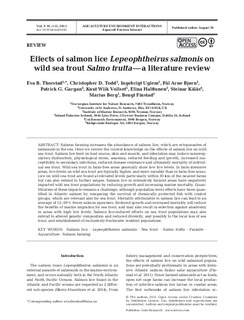Effects of salmon lice Lepeophtheirus salmonis on wild sea trout Salmo trutta—a literature review
Thorstad, Eva Bonsak; Todd, Christopher D.; Uglem, Ingebrigt; Bjørn, Pål Arne; Gargan, Patrick G.; Vollset, Knut Wiik; Halttunen, Elina; Kålås, Steinar; Berg, Marius; Finstad, Bengt
Peer reviewed, Journal article
Permanent lenke
http://hdl.handle.net/11250/2359600Utgivelsesdato
2015Metadata
Vis full innførselSamlinger
- Publikasjoner fra CRIStin - NINA [2364]
- Scientific publications [1392]
Sammendrag
Salmon farming increases the abundance of salmon lice, which are ectoparasites of
salmonids in the sea. Here we review the current knowledge on the effects of salmon lice on wild
sea trout. Salmon lice feed on host mucus, skin and muscle, and infestation may induce osmoregulatory
dysfunction, physiological stress, anaemia, reduced feeding and growth, increased susceptibility
to secondary infections, reduced disease resistance and ultimately mortality of individual
sea trout. Wild sea trout in farm-free areas generally show low lice levels. In farm-intensive
areas, lice levels on wild sea trout are typically higher, and more variable than in farm-free areas.
Lice on wild sea trout are found at elevated levels particularly within 30 km of the nearest farms
but can also extend to further ranges. Salmon lice in intensively farmed areas have negatively
impacted wild sea trout populations by reducing growth and increasing marine mortality. Quantification
of these impacts remains a challenge, although population-level effects have been quantified
in Atlantic salmon by comparing the survival of chemically protected fish with control
groups, which are relevant also for sea trout. Mortality attributable to salmon lice can lead to an
average of 12−29% fewer salmon spawners. Reduced growth and increased mortality will reduce
the benefits of marine migration for sea trout, and may also result in selection against anadromy
in areas with high lice levels. Salmon lice-induced effects on sea trout populations may also
extend to altered genetic composition and reduced diversity, and possibly to the local loss of sea
trout, and establishment of exclusively freshwater resident populations.
Salmon lice · Lepeophtheirus salmonis · Sea trout · Salmo trutta · Parasite ·
Aquaculture · Salmon farming

